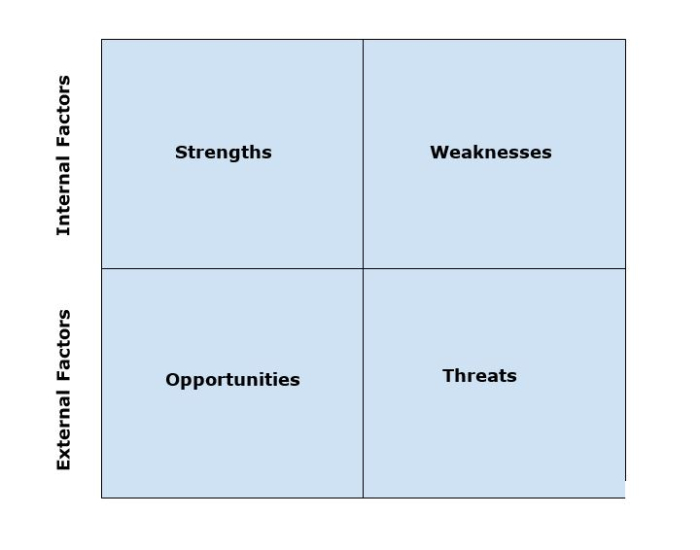
 Data Structure
Data Structure Networking
Networking RDBMS
RDBMS Operating System
Operating System Java
Java MS Excel
MS Excel iOS
iOS HTML
HTML CSS
CSS Android
Android Python
Python C Programming
C Programming C++
C++ C#
C# MongoDB
MongoDB MySQL
MySQL Javascript
Javascript PHP
PHP
- Selected Reading
- UPSC IAS Exams Notes
- Developer's Best Practices
- Questions and Answers
- Effective Resume Writing
- HR Interview Questions
- Computer Glossary
- Who is Who
Guide to SWOT Analysis for Business
SWOT analysis is a framework for analyzing a company's competitiveness in order to determine its position and create a strategic plan. A SWOT analysis assesses both internal and external elements and provides a comprehensive understanding of the company's potential. Strengths, Weaknesses, Opportunities, and Threats are referred to as SWOT.
It is used to present a practical, fact-based, and data-driven assessment of the organization's strengths and weaknesses. In order to prevent preconceived notions or grey regions and aid in focusing on real-life settings, the analysis should be accurate. It can be used by businesses as a directory rather than a prescription.
What is SWOT Analysis?

SWOT analysis is a strategy used to assess a company's performance, rivalry, risk, and potential. It can also be used to assess more specific aspects of a company, such as a product line, division, or industry. The technique can assist firms in creating successful plans, determining their position in the market, or determining why they are less successful by using internal and external data.
Components of SWOT analysis
These four categories make up every SWOT analysis. Even if each company's components and findings fall under these categories differently, the following components are necessary for a full SWOT analysis ?
Strengths
When describing what an organization excels in and what sets it apart from rivals, strengths are employed. An organization's strengths can include things like its unique technology, devoted client base, robust balance sheet, and strong brand value.
Weaknesses
Weaknesses in an organisation act as barriers that keep it from performing at its peak. In order to remain competitive, the corporation needs to modernise itself in a few areas. Poor brand value, higher-than-average turnover, high debt levels, a weak supply chain, and a cash shortage are a few of them.
Opportunities
Opportunities are beneficial external factors that give a business a competitive edge. For instance, if a country lowers its tariffs, a car manufacturer can export its cars into a new market, increasing sales and market shares.
Threats
Threats are things that are thought to be bad for a company. It most likely originates from an outside source that poses a threat to the company. For instance, a drought is regarded as a threat to a business that grows wheat since it may ruin or lower the yield of the crop. Other frequent dangers include things like a rise in material costs, increased competition, a shortage of labor, and so on.
SWOT Table
The top row of the SWOT table is frequently taken up by the internal elements, and the bottom row by the external ones. Additionally, the things in the table's left column have more favourable and favourable characteristics, whilst the items in the right column have more unfavourable and unfavourable characteristics.

Steps to do a SWOT analysis
Before and after examining the four components, a SWOT analysis can be carried out in a step-by-step approach with concrete recommendations.
Determine the Objective
Although a SWOT analysis might be wide, the likelihood of additional values being generated increases if the analysis specifically identifies the goal. For instance, if the sole focus of a SWOT analysis is the success of a new product launch. At the end of the process, the company with a target will know exactly what they hope to accomplish. The SWOT analysis can be used in this scenario to help decide whether or not to introduce the product.
Gather Resources
Because the objectives of each SWOT analysis differ from one another, the organisation requires various data sets to put up several SWOT analysis tables. A corporation must first comprehend the information that is available, the constraints it encounters, the reliability of external data sources, etc.
A business should next decide which individuals should be included in the study along with the data. Some employees may be stronger at understanding internal variables, while others may be more in tune with external pressures. A diverse range of viewpoints may also increase the likelihood of various, valuable contributions.
Compile Ideas
The team tasked with conducting the analysis should provide a list of suggestions under each category for each of the four SWOT analysis factors.
Internal Factors
Internal factors reveal the organization's advantages and disadvantages. Financial and human resources, tangible and intangible assets, brand value, and operational efficacy are a few examples of internal elements.
External Factors
Information about events occurring outside of the company is provided by external factors. For a corporation to succeed, it is just as crucial as internal elements. The following are some instances of external influences: monetary policies, market fluctuations, supplier access, etc. These categories help to clarify the state of the market and to identify opportunities and dangers.
Possible questions to list in a SWOT Analysis |
|
|---|---|
Strengths |
Weaknesses |
|
|
Opportunities |
Threats |
|
|
Refine Findings
Each idea can be cleaned up after creating a list of ideas under each category. A corporation can concentrate solely on the best concepts or the biggest hazards to the organization by removing the staff members' other suggestions. Significant discussion among participants is needed at this point, and higher management must help rank priorities.
Develop the Strategy
The SWOT analysis can now be transformed into a strategic plan with the use of the prioritized list of the company's strengths, weaknesses, opportunities, and threats. Analysts can now construct a synthesized plan to direct the organization toward achieving its original goal by taking into account the prioritized list of things inside each category.
Conclusion
One of the most used analytical methods is a SWOT analysis. It is strategically employed to pinpoint problem areas and determine a company's competitive edge. A SWOT analysis examines a company's strengths and areas of excellence as well as its weaknesses, giving it a comprehensive understanding of the most harmful aspects of a corporation. It enables a business to take more informed decisions in order to protect its strengths, build on its deficiencies, reduce risk, and prepare for potential future negative events.

